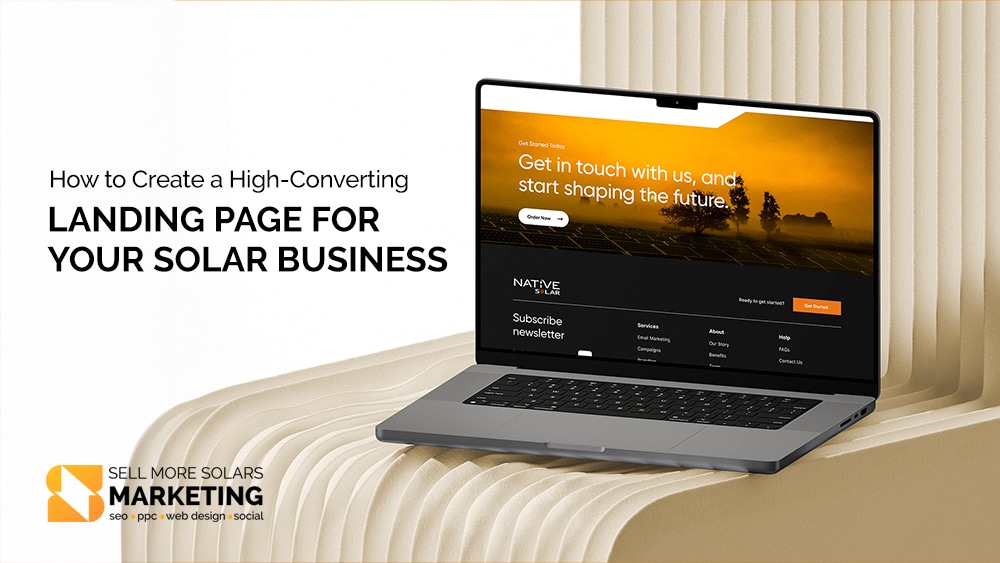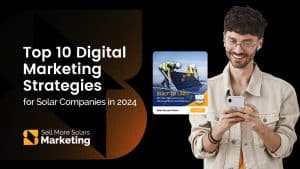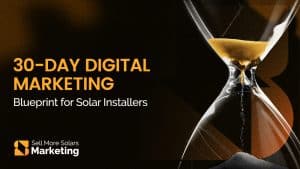In today’s competitive renewable energy market, having a high-converting landing page for your solar business is essential to attract leads and turn them into customers. A well-designed solar landing page presents your products and services and also persuades visitors to take action, whether it’s scheduling a consultation, requesting a quote, or signing up for a newsletter. In this blog, we’ll guide you through the key elements of creating an effective landing page that drives results.
Key Elements to Create a High-Converting Landing Page for Your Solar Business

1. Start with a Clear and Compelling Headline
Your headline is the first thing visitors see, and it should immediately communicate your value proposition and set expectations for what they’ll gain by engaging with your page.For a solar business, this could mean emphasizing cost savings, environmental benefits, or cutting-edge technology.
Why a Strong Headline Matters
The average visitor spends 10-20 seconds deciding if a webpage is worth their time. A clear and compelling headline instantly communicates the benefits of your solar business, encouraging visitors to stay and explore further. It’s your chance to create a strong first impression.
Example:
Save Up to 30% on Your Energy Bills with Solar Power!
A powerful headline sets the tone for the rest of your solar landing page and encourages users to stay and explore further.
Design Tips for Headlines
- Placement: Position your headline at the top of the page, ensuring it’s the first thing visitors see.
- Font Size and Style: Use a bold and legible font to make it stand out. Contrast the color against the background for better visibility.
- Conciseness: Keep it short and impactful—aim for no more than 8-12 words.
2. Focus on Benefits, Not Just Features
When developing your solar landing page, remember that potential customers are more interested in how your solutions will improve their lives rather than the technical specifications of your products. Instead of listing features like panel efficiency or warranty durations, emphasize the tangible benefits that directly address their needs and concerns.
Key benefits to emphasize:
- Reduction in energy costs.
- Contribution to a greener planet.
- Government incentives or tax benefits for switching to solar.
Pair benefits with relatable visuals to drive the message home and create a high-converting landing page experience.
3. Use a Clear Call-to-Action (CTA)
Every solar landing page should have a crystal-clear CTA that directs visitors toward your desired action, whether that’s requesting a free quote, scheduling a consultation, or downloading a brochure.
Best practices for CTAs:
- Use actionable language like “Get Your Free Solar Quote Today”.
- Make CTAs stand out with contrasting colors.
- Place CTAs strategically throughout the page (above the fold, mid-page, and at the bottom).
4. Use Social Proof and Testimonials
Adding testimonials and case studies from satisfied customers builds trust and credibility. When potential clients see real-world success stories, they’re more likely to believe in the value of your services.
Examples of social proof to include:
- Star ratings or reviews.
- Quotes from happy customers.
- Before-and-after comparisons showcasing energy savings after installing solar panels.
5. Highlight Special Offers or Incentives
Everyone loves a good deal. Offering limited-time promotions or exclusive discounts can nudge visitors toward making a decision.
Examples of effective offers:
- Get 20% Off Installation Costs – Offer Ends Soon!
- Sign Up Today and Receive a Free Solar Energy Audit!
To maximize the impact of these offers, position them prominently on your solar landing page, such as in a banner near the top or next to your call-to-action button. Use bold text, bright colors, and countdown timers to emphasize urgency and exclusivity. By making these incentives highly visible and time-sensitive, you create a compelling reason for visitors to engage with your solar business immediately.
6. Optimize for Mobile Devices
More than half of web traffic comes from mobile devices, so your solar landing page must look and perform seamlessly on smartphones and tablets.
Mobile optimization tips:
- Ensure fast page load times. Mobile users are often on the go, so a slow-loading page can cost you potential leads. Compress images, use caching, and minimize code to improve loading speed.
- Use responsive design so elements, such as text, images, and buttons, adjust automatically to fit various screen sizes without sacrificing readability or functionality. This guarantees your solar landing page looks great on any device.
- Simplify navigation for touch-friendly usability. Mobile screens are smaller, so cluttered layouts or complex menus can frustrate users. Design for touch-friendly usability by including large, easy-to-tap buttons, improved menus, and minimal scrolling requirements.
7. Incorporate High-Quality Visuals and Videos
Visuals are essential for making your high-converting landing page appealing and engaging. Use high-resolution images of solar panels, installations, and eco-friendly homes to connect with your audience.
Videos can further enhance engagement by showing:
- How your solar systems work.
- Customer success stories.
- Your team’s expertise and commitment to quality.
8. Include Trust Signals and Certifications
Building trust is crucial in converting visitors into leads. Displaying certifications, awards, or partnerships signals that your business is reputable and reliable.
Examples of trust signals:
- Industry certifications (e.g., NABCEP).
- Logos of partner organizations.
- Security badges for online forms.
9. Simplify the Lead Capture Form
A lead capture form is one of the most critical elements of your high-converting landing page because it’s where visitors take action and become potential customers. However, a form that is too long or complicated can deter visitors, causing them to abandon the page before completing the process. To avoid this, keep the form short, simple, and focused only on gathering essential information. Limit the fields to what’s absolutely necessary, such as the visitor’s name, email, phone number, and location. This makes it easier for users to fill out and reduces any friction that could lead to form abandonment.
Pro tip:
To further incentivize users to complete the form, offer something of value in exchange for their information. For example, providing a free consultation, energy savings report, or a downloadable guide on how solar can reduce their energy bills gives them a tangible benefit for sharing their contact details.
10. Test and Optimize Regularly
Even the best solar landing page needs ongoing optimization. Use A/B testing to experiment with different elements like headlines, CTAs, or layouts.
Metrics to track:
- Conversion rates.
- Bounce rates.
- Click-through rates on CTAs.
Based on these insights, make adjustments to improve performance and ensure your page remains a high-converting landing page over time.
How Can Sell More Solars Help?
At Sell More Solars, we specialize in helping solar companies effectively market their services and reach a wider audience. Our expert website design services help you create high-converting landing pages that incorporate all the essential elements needed for success. From clear and compelling headlines to user-friendly navigation and mobile optimization, we ensure that your landing page looks professional and also converts visitors into leads.
Final Thoughts
Creating a high-converting landing page for your solar business is an art and a science. By focusing on clarity, user experience, and trust, you can design a page that attracts, engages, and converts visitors into loyal customers. Implement these strategies on your next solar landing page, and watch your leads and sales soar!










